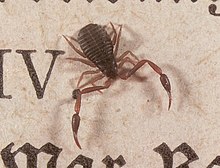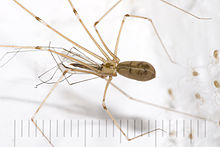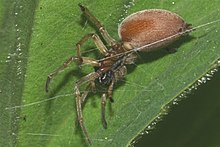List of arachnids of Ireland












There are approximately 1,107 species of arachnid native to Ireland.[11] Not up to date for all taxa. Arachnids are eight-legged chelicerate arthropods with pedipalps and bodies divided into two tagmata.
The most best known and familiar group in Ireland is the spiders, and there are also several species of harvestman (daddy-long-legs), ticks, mites and pseudoscorpions. Arachnid groups absent from Ireland include true scorpions, whip scorpions, solifuges, cave spiders, microwhip scorpions, hooded tick spiders and tarantulas.
15 native species and three species which are not considered to be native: Odiella spinosus, Opilio parietinus (Phalangiidae) and Dicranopalpus ramosus (Leiobunidae)
Family Nemastomatidae
[edit]Family Phalangiidae
[edit]- Dicranopalpus ramosus
- Lacinius ephippiatus
- Megabunus diadema
- Mitopus morio
- Oligolophus hanseni
- Oligolophus tridens
- Opilio parietinus
- Opilio saxatilis
- Paroligolophus agrestis
- Phalangium opilio
- Rilaena triangularis (Paraplatybunus triangularis)
Family Sclerosomatidae
[edit]Family Trogulidae
[edit]Order Pseudoscorpionida (false scorpions)
[edit]17 species
Family Cheiridiidae
[edit]Family Cheliferidae
[edit]- House pseudoscorpion (Chelifer cancroides)
Family Chernetidae
[edit]- Allochernes powelli
- Dinocheirus panzeri
- Lamprochernes nodosus
- Lamprochernes savignyi
- Pselaphochernes dubius
- Pselaphochernes scorpioides
Family Chthonidae
[edit]Family Chthoniidae
[edit]Family Neobisiidae
[edit]- Neobisium carcinoides
- Neobisium carpenteri
- Neobisium maritimum
- Roncocreagris cambridgei
- Roncus lubricus
At least 684 species
10 species
- Dermacentor reticulatus
- Castor bean tick (Ixodes ricinus)
2 species
Order Prostigmata (sucking true mites)
[edit]249 species
4 species
Family Arrenuridae
[edit]5 species
5 species
Family Ereynetidae
[edit]1 species
Family Eriophyidae (gall mites)
[edit]52 species [12]
- Aceria cephalonea
- Sycamore felt gall mite (Aceria pseudoplatani)
- Eriophyes exilis
- Eriophyes laevis
- Eriophyes macrorhynchus subsp. aceribus
- Eriophyes prunispinosae
- Eriophyes pyri
- Eriophyes similis
- Phyllocoptes goniothorax
- Phyllocoptes malinus
- Big bud gall mite (Phytoptus avellanae)
Family Erythraeidae
[edit]7 species
2 species
3 species
Family Halacaridae (marine mites)
[edit]44 species
Family Hydrodromidae
[edit]1 species
- Yellow foot mite (Hydrodroma despiciens)
2 species [13]
Family Hydryphantidae
[edit]2 species
Family Hygrobatidae
[edit]6 species
Family Lebertiidae
[edit]11 species
Family Limnesiidae
[edit]2 species
Family Meyerellidae
[edit]3 species
Family Microtrombidiidae
[edit]4 species
1 species
Family Mideopsidae
[edit]1 species
Family Nanorchestidae
[edit]2 species
1 species
Family Penthaleidae
[edit]2 species
Family Phytoptidae
[edit]2 species
14 species
Family Podothrombiidae
[edit]1 species
Family Rhagidiidae
[edit]4 species
Family Scutacaridae
[edit]1 species
Family Sperchontidae
[edit]7 species
Family Stigmaeidae
[edit]3 species
Family Tanaupodidae
[edit]1 species
Family Tarsonemidae
[edit]14 species
Family Tetranychidae
[edit]6 species
Family Teutoniidae
[edit]1 species
Family Torrenticolidae
[edit]9 species
Family Trombiculidae
[edit]1 species
15 species
Family Unionicolidae
[edit]6 species
Order Sarcoptiformes (Clade)
[edit]173 species have been identified for the Republic of Ireland
Family Achipteriidae
[edit]4 species
Family Adelphacaridae
[edit]1 species
Family Ameronothridae
[edit]7 species
Family Banksinomidae
[edit]1 species
1 species
Family Brachychthoniidae
[edit]19 species
Family Caleremaeidae
[edit]1 species
Family Camisiidae
[edit]6 species
3 species
Family Cosmochthoniidae
[edit]1 species
Family Euphthiracaridae
[edit]1species
2 species
Family Hermanniidae
[edit]7 species
Family Hypochthoniidae
[edit]2 species
1 species
Family Malaconothridae
[edit]6 species
Family Mycobatidae
[edit]4 species
Family Nanhermanniidae
[edit]4 species
2 species
Family Perlohmanniidae
[edit]1 species
Family Phthiracaridae
[edit]4 species
Suborder Brachypylina
[edit]Family Carabodidae
[edit]5 species
Family Ceratozetidae
[edit]12 species
Family Chamobatidae
[edit]4 species
Family Ctenobelbidae
[edit]1 species
Family Cymbaeremaeidae
[edit]1 species
3 species
Family Eremaeidae
[edit]1 species
Family Galumnidae
[edit]2 species
Family Haplozetidae
[edit]1 species
Family Humerobatidae
[edit]1 species
Family Hydrozetidae
[edit]1 species
Family Liacaridae
[edit]4 species
Family Limnozetidae
[edit]2 species
Family Metrioppiidae
[edit]1 species
Family Micreremidae
[edit]1 species
Family Neoliodidae
[edit]1 species
16 species
Family Oribatellidae
[edit]3 species
Family Oribatulidae
[edit]7 species
Family Passalozetidae
[edit]1 species
Family Phenopelopidae
[edit]8 species
Family Protoribatidae
[edit]1 species
Family Protoribatidae
[edit]1 species
Family Punctoribatidae
[edit]1 species
Family Quadroppiidae
[edit]1 species
Family Scheloribatidae
[edit]2 species
Family Scutoverticidae
[edit]2 species
Family Steganacaridae
[edit]2 species
Family Suctobelbidae
[edit]6 species
Family Tectocepheidae
[edit]1 species
Family Thyrisomidae
[edit]2 species
Family Xenillidae
[edit]1 species
Suborder Astigmatina
[edit]Order Trombidiformes
[edit]Family Limnocharidae
[edit]Family Tarsonemidae (thread-footed mites / white mites)
[edit]- Some species
Family Trombidiidae (red velvet mites)
[edit]390 species belonging to 31 families
Family Agelenidae (funnel-web spiders)
[edit]- Agelena labyrinthica
- Cryphoeca silvicola (C.L. Koch, 1834)
- Eratigena agrestis
- Giant house spider (Eratigena atrica)
- Malthonica pagana C.L. Koch, 1841
- Tegenaria domestica
- Tegenaria parietina
- Tegenaria silvestris
- Textrix denticulata (Olivier, 1789)
Family Amaurobiidae (tangled nest spiders)
[edit]- Amaurobius fenestralis (Lace-webbed spider)
- Amaurobius ferox (black lace-weaver)
- Amaurobius similis (Lace-webbed spider)
Family Anyphaenidae
[edit]- Anyphaena accentuata (Walckenaer, 1802)
- Agalenatea redii
- European garden spider (Araneus diadematus)
- Four-spot orbweaver (Araneus quadratus)
- Araneus sturmi
- Araneus triguttatus
- Cucumber green spider (Araniella cucurbitina)
- Araniella opisthographa (Kulczynski, 1905)
- Araniella displicata (Hentz, 1847)
- Atea triguttata (Fabricius, 1775)
- Cyclosa conica
- Gibbaranea gibbosa
- Hypsosinga albovittata
- Hypsosinga pygmaea
- Furrow orb spider (Larinioides cornutus)
- Larinioides patagiatus (Clerck, 1757)
- Larinioides sclopetarius (Clerck, 1757)
- Mangora acalypha (Walckenaer, 1802)
- Walnut orb-weaver spider (Nuctenea umbratica)
- Zygiella atrica
- Silver-sided sector spider (Zygiella x-notata)
Family Cheiracanthiidae
[edit]- Cheiracanthium erraticum (Walckenaer, 1802)
- Cheiracanthium virescens (Sundevall, 1833)
Family Clubionidae (sac spiders)
[edit]- Clubiona brevipes
- Clubiona comta
- Clubiona diversa
- Clubiona juvenis Simon, 1878
- Clubiona lutescens
- Clubiona neglecta
- Clubiona pallidula
- Clubiona phragmitis
- Clubiona reclusa
- Clubiona stagnatilis
- Clubiona subtilis
- Clubiona terrestris
- Clubiona trivialis
- Diving bell spider (Argyroneta aquatica)
Family Dictynidae
[edit]- Argenna subnigra (O.P.-Cambridge, 1861)
- Dictyna arundinacea
- Dictyna latens
- Dictyna uncinata Thorell, 1856
- Nigma puella
Family Dysderidae (woodlouse hunters)
[edit]- Woodlouse spider (Dysdera crocata)
- Dysdera erythrina
- Harpactea hombergi (Scopoli, 1763)
Family Gnaphosidae (flat-bellied ground spiders)
[edit]- Drassodes cupreus
- Drassodes lapidosus (Walckenaer, 1802)
- Drassyllus lutetianus (L. Koch, 1866)
- Drassyllus pusillus
- Haplodrassus signifer
- Micaria pulicaria
- Scotophaeus blackwalli
- Zelotes apricorum (L. Koch, 1876)
- Zelotes electus (C.L.Koch, 1839)
- Zelotes latreillei (Simon, 1878)
- Antistea elegans
- Hahnia helveola Simon, 1875
- Hahnia montana (Blackwall, 1841)
- Hahnia nava
- Hahnia pusilla
Family Linyphiidae (sheet weavers)
[edit]- Agyneta cauta
- Agyneta decora (O.P.-Cambridge, 1871)
- Agyneta conigera
- Agyneta olivacea
- Agyneta ramosa
- Agyneta subtilis
- Allomengea scopigera (Grube, 1859)
- Allomengea vidua (L.Koch, 1879)
- Aphileta misera (O.P.-Cambridge, 1882)
- Araeoncus crassiceps(Westring, 1861)
- Araeoncus humilis
- Asthenargus paganus (Simon, 1884)
- Baryphyma gowerense (Locket, 1965)
- Baryphyma trifrons (O.P.-Cambridge, 1863)
- Bathyphantes approximatus (O.P.-Cambridge, 1871)
- Bathyphantes gracilis
- Bathyphantes nigrinus (Westring, 1851)
- Bathyphantes parvulus (Westring, 1851)
- Bathyphantes setiger F.O.P.-Cambridge, 1894
- Bolyphantes alticeps (Sundevall, 1833)
- Bolyphantes luteolus (Blackwall, 1833)
- Carorita limnaea (Crosby & Bishop, 1927)
- Carorita paludosa Duffey, 1971
- Centromerita bicolor (Blackwall, 1833)
- Centromerita concinna (Thorell, 1875)
- Centromerus arcanus (O.P.-Cambridge, 1873)
- Centromerus dilutus (O.P.-Cambridge, 1875)
- Centromerus levitarsis (Simon, 1884)
- Centromerus prudens (O.P.-Cambridge, 1873)
- Ceratinella brevipes (Westring, 1851)
- Ceratinella brevis (Wider, 1834)
- Ceratinella scabrosa (O.P.-Cambridge, 1871)
- Centromerus persimilis (O.P.-Cambridge, 1912)
- Centromerus sylvaticus (Blackwall, 1841)
- Cnephalocotes obscurus (Blackwall, 1834)
- Collinsia inerrans (O.P.-Cambridge, 1885)
- Dicymbium brevisetosum Locket, 1962
- Dicymbium nigrum (Blackwall, 1834)
- Dicymbium tibiale (Blackwall, 1836)
- Diplocentria bidentata (Emerton, 1882)
- Diplocephalus cristatus (Blackwall, 1833)
- Diplocephalus latifrons (O.P.-Cambridge, 1863)
- Diplocephalus permixtus (O.P.-Cambridge, 1871)
- Diplocephalus picinus (Blackwall, 1841)
- Diplostyla concolor (Wider, 1834)
- Dismodicus bifrons (Blackwall, 1841)
- Donacochara speciosa (Thorell, 1875)
- Invisible spider (Drapetisca socialis(Sundevall, 1833))
- Drepanotylus uncatus (O.P.-Cambridge, 1873)
- Entelecara errata O.P.-Cambridge, 1913
- Entelecara erythropus (Westring, 1851)
- Entelecara media Kulczynski, 1887
- Entelecara omissa (O.P.-Cambridge, 1902)
- Erigone arctica (White, 1852)
- Erigone atra
- Erigone dentipalpis (Wider, 1834)
- Erigone longipalpis
- Erigone capra Simon, 1884
- Erigone promiscua (O.P.-Cambridge, 1872)
- Erigone welchi Jackson, 1911
- Erigonella hiemalis (Blackwall, 1841)
- Erigonella ignobilis (O.P.-Cambridge, 1871)
- Evansia merens O.P.-Cambridge, 1900
- Floronia bucculenta
- Glyphesis cottonae (La Touche, 1945)
- Gnathonarium dentatum (Wider, 1834)
- Gonatium rubellum (Blackwall, 1841)
- Gonatium rubens
- Gongylidiellum latebricola (O.P.-Cambridge, 1871)
- Gongylidiellum murcidum Simon, 1884
- Gongylidiellum vivum (O.P.-Cambridge, 1875)
- Gongylidium rufipes (Linnaeus, 1758)
- Halorates reprobus (O.P.-Cambridge, 1879)
- Helophora insignis (Blackwall, 1841)
- Hilaira excisa (O.P.-Cambridge, 1871)
- Hilaira frigida (Thorell, 1872)
- Hilaira pervicax Hull, 1908
- Hylyphantes graminicola
- Hypselistes jacksoni (O.P.-Cambridge, 1902)
- Hypomma bituberculatum (Wider, 1834)
- Hypomma cornutum (Blackwall, 1833)
- Hypomma fulvum Büsenberg, 1902
- Jacksonella falconeri (Jackson, 1908)
- Kaestneria dorsalis (Wider, 1834)
- Kaestneria pullata (O.P.-Cambridge, 1863)
- Labulla thoracica (Wider, 1834)
- Lepthyphantes alacris (Blackwall, 1853) = Tenuiphantes
- Lepthyphantes angulatus (O.P.-Cambridge, 1881) = Oryphantes
- Lepthyphantes cristatus (Menge, 1866) = Tenuiphantes
- Lepthyphantes ericaeus (Blackwall, 1853)
- Lepthyphantes flavipes (Blackwall, 1854)
- Lepthyphantes insignis O.P.-Cambridge, 1913 = Tenuiphantes
- Lepthyphantes mengei Kulczynski, 1887
- Lepthyphantes minutus
- Lepthyphantes nebulosus (Sundevall, 1830) = Tenuiphantes
- Lepthyphantes obscurus (Blackwall, 1841) = Centromerus
- Lepthyphantes pallidus (O.P.-Cambridge, 1871) = Tenuiphantes
- Lepthyphantes tenebricola (Wider, 1834) = Tenuiphantes
- Lepthyphantes tenuis
- Lepthyphantes whymperi F.O.P.-Cambridge, 1894 = Tenuiphantes
- Lepthyphantes zimmermanni Bertkau, 1890 = Tenuiphantes
- Leptorhoptrum robustum (Westring, 1851)
- Leptothrix hardyi (Blackwall, 1850)
- Lessertia dentichelis (Simon, 1884)
- Linyphia hortensis
- Linyphia triangularis
- Lophomma punctatum (Blackwall, 1841)
- Macrargus rufus (Wider, 1834)
- Maro minutus O.P.-Cambridge, 1906
- Maso sundevalli (Westring, 1851)
- Mecopisthes peusi Wunderlich, 1972
- Meioneta beata (O.P.-Cambridge, 1906)
- Meioneta gulosa (C.L. Koch, 1869)
- Meioneta innotabilis (O.P.-Cambridge, 1863)
- Meioneta mollis
- Meioneta mossica Schikora, 1993
- Meioneta rurestris
- Meioneta saxatilis sensu stricto (Blackwall, 1844)
- Metopobactrus prominulus (O.P.-Cambridge, 1872)
- Micrargus herbigradus sensu stricto (Blackwall, 1854)
- Micrargus subaequalis (Westring, 1851)
- Microctenonyx subitaneus (O.P.-Cambridge, 1875)
- Microlinyphia impigra (O.P.-Cambridge, 1871)
- Microlinyphia pusilla
- Microneta viaria
- Minicia marginella (Wider, 1834)
- Minyriolus pusillus (Wider, 1834)
- Mioxena blanda (Simon, 1884)
- Moebelia penicillata (Westring, 1851)
- Monocephalus castaneipes (Simon, 1884)
- Monocephalus fuscipes (Blackwall, 1836)
- Neriene clathrata (Sundevall, 1830)
- Neriene montana
- Neriene peltata
- Oedothorax agrestis (Blackwall, 1853)
- Oedothorax apicatus (Blackwall, 1850)
- Oedothorax fuscus (Blackwall, 1834)
- Oedothorax gibbosus
- Oedothorax retusus (Westring, 1851)
- Ostearius melanopygius (O.P.-Cambridge, 1879)
- Oreonetides vaginatus (Thorell, 1872)
- Pelecopsis mengei (Simon, 1884)
- Pelecopsis nemoralis (Blackwall, 1841)
- Pelecopsis parallela (Wider, 1834
- Peponocranium ludicrum (O.P.-Cambridge, 1861)
- Pocadicnemis juncea Locket & Millidge, 1953
- Pocadicnemis pumila sensu stricto (Blackwall, 1841)
- Poeciloneta variegata (Blackwall, 1841)
- Porrhomma campbelli F.O.P.-Cambridge, 1894
- Porrhomma convexum (Westring, 1851)
- Porrhomma egeria Simon, 1884
- Porrhomma errans (Blackwall, 1841)
- Porrhomma montanum Jackson, 1913
- Porrhomma oblitum (O.P.-Cambridge, 1871)
- Porrhomma pallidum Jackson, 1913
- Porrhomma pygmaeum
- Porrhomma rosenhaueri (L. Koch, 1872)
- Praestigia duffeyi (Millidge, 1954)
- Rhaebothorax morulus (O.P.-Cambridge, 1873)
- Saaristoa abnormis (Blackwall, 1841)
- Saaristoa firma (O.P.-Cambridge, 1905)
- Saloca diceros (O.P.-Cambridge, 1871)
- Satilatlas britteni (Jackson, 1913)
- Savignia frontata
- Semljicola fausta (O.P.-Cambridge, 1900) = Eboria
- Silometopus ambiguus (O.P.-Cambridge, 1905)
- Silometopus elegans (O.P.-Cambridge, 1872)
- Silometopus incurvatus (O.P.-Cambridge, 1873)
- Silometopus reussi (Thorell, 1871)
- Sintula corniger (Blackwall, 1856)
- Stemonyphantes lineatus (Linnaeus, 1758)
- Styloctetor stativus (Simon, 1881)
- Tallusia experta (O.P.-Cambridge, 1871)
- Tapinocyba insecta (L. Koch, 1869)
- Tapinocyba pallens (O.P.-Cambridge, 1872)
- Tapinocyba praecox (O.P.-Cambridge, 1873)
- Tapinopa longidens
- Taranucnus setosus (O.P.-Cambridge, 1863)
- Thyreosthenius parasiticus (Westring, 1851)
- Tiso vagans (Blackwall, 1834)
- Tmeticus affinis (Blackwall, 1855)
- Trichoncus saxicola (O.P.-Cambridge, 1861)
- Trichopterna thorelli (Westring, 1861)
- Troxochrus cirrifrons (O.P.-Cambridge, 1871)
- Troxochrus scabriculus (Westring, 1851)
- Typhochrestus digitatus (O.P.-Cambridge, 1872)
- Walckenaeria acuminata
- Walckenaeria alticeps (Denis, 1952)
- Walckenaeria antica
- Walckenaeria atrotibialis
- Walckenaeria capito (Westring, 1861)
- Walckenaeria clavicornis (Emerton, 1882)
- Walckenaeria corniculans (O.P.-Cambridge, 1875)
- Walckenaeria cucullata (C.L. Koch, 1836)
- Walckenaeria cuspidata Blackwall, 1833
- Walckenaeria dysderoides (Wider, 1834)
- Walckenaeria kochi (O.P.-Cambridge, 1872)
- Walckenaeria monoceros (Wider, 1834)
- Walckenaeria nodosa
- Walckenaeria nudipalpis
- Walckenaeria unicornis O.P.-Cambridge, 1861
- Walckenaeria vigilax
Family Liocranidae (Liocranid sac spiders)
[edit]- Agraecina striata (Kulczynski, 1882)
- Agroeca proxima (O.P.-Cambridge, 1871)
- Liocranum rupicola
- Phrurolithus festivus (C.L. Koch, 1835)
- Scotina gracilipes (Blackwall, 1859)
- Scotina celans (Blackwall, 1841)
- Alopecosa cuneata (Clerck, 1757)
- Alopecosa pulverulenta
- Arctosa cinerea (Fabricius, 1777)
- Arctosa leopardus (Sundevall, 1833)
- Arctosa perita (Latreille, 1799)
- Pardosa agrestis (Westring, 1861)
- Pardosa agricola
- Spotted wolf spider (Pardosa amentata)
- Pardosa lugubris
- Pardosa monticola
- Pardosa nigriceps
- Pardosa palustris
- Pardosa prativaga (L.Koch, 1870)
- Pardosa purbeckensis O.P.-Cambridge, 1895
- Pardosa pullata (Clerck, 1757)
- Pardosa saltans Töpfer-Hofmann, 2000
- Pirata hygrophilus Thorell, 1872
- Pirata latitans (Blackwall, 1841)
- Pirata piraticus
- Pirata piscatorius (Clerck, 1757)
- Pirata tenuitarsis Simon, 1876
- Pirata uliginosus (Thorell, 1856)
- Trochosa ruricola
- Trochosa spinipalpis
- Trochosa terricola
Family Miturgidae
[edit]Family Nesticidae (scaffold web spiders)
[edit]Family Philodromidae (running crab spiders)
[edit]- Philodromus aureolus
- Philodromus cespitum
- Philodromus dispar Walckenaer, 1826
- Philodromus emarginatus (Schrank, 1803)
- Thanatus striatus
- Tibellus maritimus (Menge, 1875)
- Tibellus oblongus
- Skull spider (Pholcus phalangioides)
Family Pisauridae (nursery web spiders)
[edit]- Raft spider (Dolomedes fimbriatus)
- Pisaura mirabilis
Family Salticidae (jumping spiders)
[edit]- Calositticus caricis (syn. Sitticus caricis)
- Euophrys frontalis
- Evarcha falcata
- Heliophanus cupreus
- Heliophanus flavipes (Hahn, 1832)
- Marpissa nivoyi (Lucas, 1846)
- Neon reticulatus
- Neon robustus Lohmander, 1945
- Pseudeuophrys erratica
- Pseudeuophrys lanigera
- Salticus scenicus
- Salticus cingulatus (Panzer, 1797)
- Sitticus floricola
- Sitticus pubescens (Fabricius, 1775)
- Talavera aequipes
- Talavera petrensis C.L. Koch, 1837
Family Segestriidae (tube-dwelling spiders)
[edit]- Snake-back spider (Segestria senoculata)
Family Scytodidae
[edit]- Scytodes thoracica Latreille, 1804
Family Sparassidae
[edit]- Micrommata roseum (Clerck, 1757)
Family Tetragnathidae (long-jawed orb weavers)
[edit]- European cave spider (Meta menardi)
- Metellina mengei
- Metellina merianae
- Metellina segmentata
- Pachygnatha clercki
- Pachygnatha degeeri
- Pachygnatha listeri Sundevall, 1830
- Tetragnatha extensa
- Tetragnatha montana Simon, 1874
- Tetragnatha nigrita Lendl, 1886
- Tetragnatha obtusa C.L. Koch, 1837
- Tetragnatha pinicola L. Koch, 1870
- Tetragnatha striata L. Koch, 1862
Family Theridiidae (tangle-web spiders)
[edit]- Achaearanea lunata (Clerck, 1757)= Parasteatoda
- Achaearanea tepidariorum = Parasteatoda
- Anelosimus vittatus (C.L.Koch, 1836)
- Asagena phalerata (Panzer, 1801)
- Crustulina sticta
- Cryptachaea riparia
- Dipoena melanogaster
- Dipoena tristis (Hahn, 1833)
- Enoplognatha ovata
- Enoplognatha latimana Hippa & Oksala 1982
- Enoplognatha thoracica
- Episinus angulatus
- Episinus truncatus
- Euryopis flavomaculata
- Neottiura bimaculata
- Paidiscura pallens (Blackwall, 1834)
- Pholcomma gibbum (Westring, 1851)
- Platnickina tincta
- Robertus arundineti (O.P.-Cambridge, 1871)
- Robertus lividus (Blackwall, 1836)
- Robertus neglectus
- Rugathodes bellicosus
- Rugathodes instabilis (O.P.-Cambridge, 1871)
- Simitidion simile (C.L.Koch, 1836)
- Rabbit-hutch spider (Steatoda bipunctata; also called "false widow")
- Steatoda grossa
- Steatoda nobilis
- Steatoda paykulliana ("false widow")
- Theonoe minutissima (O.P.-Cambridge, 1879)
- Theridion blackwalli O.P.-Cambridge, 1871
- Theridion impressum L.Koch, 1881 = Phylloneta
- Theridion melanurum Hahn, 1831
- Theridion mystaceum L.Koch, 1870
- Theridion sisyphium (Clerck, 1757) = Phylloneta
- Theridion varians
Family Theridiosomatidae (ray spiders)
[edit]Family Thomisidae (crab spiders)
[edit]- Diaea dorsata
- Goldenrod crab spider (Misumena vatia)
- Ozyptila atomaria
- Ozyptila brevipes (Hahn, 1826)
- Ozyptila sanctuaria (O.P.-Cambridge, 1871)
- Ozyptila trux
- Ozyptila praticola (C.L. Koch, 1837)
- Xysticus audax
- Xysticus cristatus
- Xysticus erraticus (Blackwall, 1834)
- Xysticus lanio
- Xysticus luctuosus (Blackwall, 1836)
- Xysticus sabulosus (Hahn, 1832)
- Xysticus ulmi
Family Uloboridae (hackled orb weavers)
[edit]See also
[edit]Encyclopedia of Life online has many images via search Dictynoidea Placements
References
[edit]- ^ a b "Species Details".
- ^ "Species Details".
- ^ "Species Details".
- ^ "Red Velvet Mite - Red Earth Mite - Trombidium holosericeum". Archived from the original on November 23, 2008.
- ^ "Species Details".
- ^ "Species Browser".
- ^ "Species Details".
- ^ "Species Details".
- ^ "Species Details".
- ^ "Species Details".
- ^ Ferriss, S. E., Smith, K. G. and Inskipp, T. P.(editors), 2009 Irish Biodiversity: a taxonomic inventory of fauna. Online here: [1]
- ^ O'Connor, J.P., O'Connor, M.A., Ashe, P. & Wistow, S. 1999 A review of the Irish gall-mites (Acari: Eriophydae). Irish Naturalists' Journal 26: 241-248
- ^ Gledhill, T. & Viets K.O. (1976) A synonymic and bibliographic check-list of the freshwater mites (Hydrachnellae and Limnohalacaridae, Acari) recorded from Great Britain and Ireland. Freshwater Biological Association of Occasional Publishing, 1, 1–59.
Helsdingen, P.J. van, 1996 A county distribution of Irish spiders, incorporating a revised catalogue of the species Irish Naturalists' Journal Special Issue
Further information
[edit]Identification
[edit]Key works are:-
- Jones, Dick, 1983 The Country Life Guide to spiders of Britain and Northern Europe Country Life Books/Hamlyn
- Jones-WaltersL.M., Keys to Families of British Spiders AIDGAP Guide, Field Studies Council No. 197, 1989.
- Locket, G.H. and Millidge, A.F. British Spiders . Vol I 1951, Vol II 1953 Ray Society of London.
- Locket, G.H., Millidge, A.F. and Merrett P. British Spiders Vol III 1974 Ray Society of London.
- Roberts, Michael J., The Spiders of Great Britain and Ireland Vols I, II, 1985, III 1987. Harley Books
- Roberts, Michael J., 1993 The Spiders of Great Britain and Ireland Compact Edition Harley Books, 1993
- Roberts, Michael J., 1995 Collins Field Guide: Spiders of Britain and Northern Europe Harper Collins
Peter C. Barnard, 1999 Identifying British insects and arachnids: an annotated bibliography of key works Cambridge University Press ISBN 0 521 63241 2 provides a comprehensive list of identification literature.
External links
[edit]- Wolfgang Nentwig, Theo Blick, Daniel Gloor, Ambros Hänggi & Christian Kropf Eds. Araneae of Europe Includes Descriptions, family keys, figures (pedipalps, epigyne, vulva, prosoma, eyes etc.), maps, references, image gallery. Search under species as generic placements differ
- Spinnen-forum.de Comprehensive expert Wiki images, distribution (by species but under genus IE is Ireland, maps, references, descriptions in German
- British Spiders
- Biolib taxonomy, images
